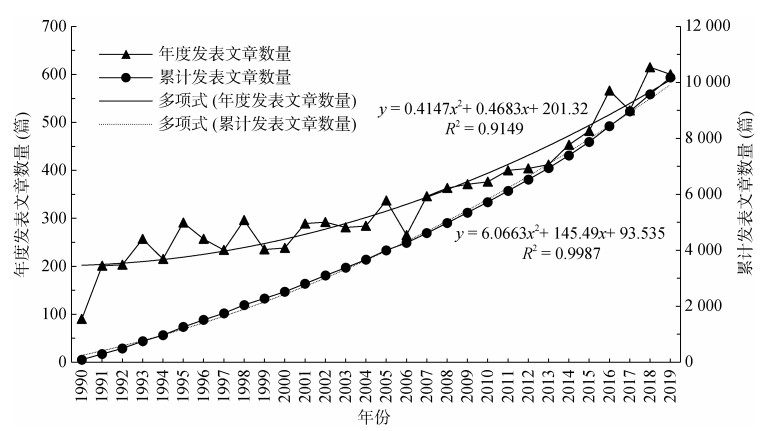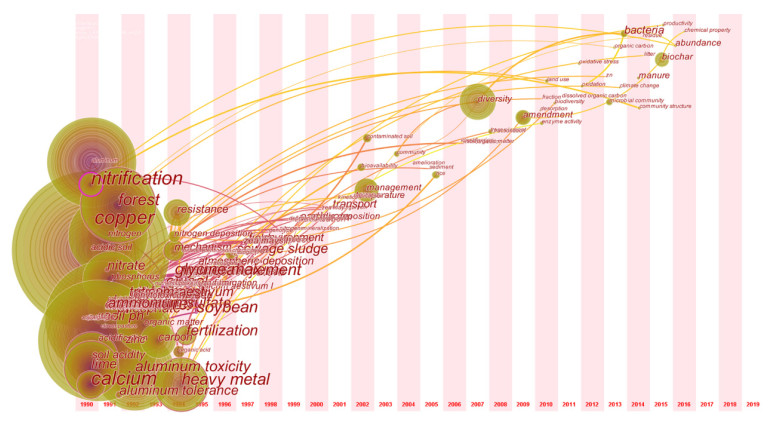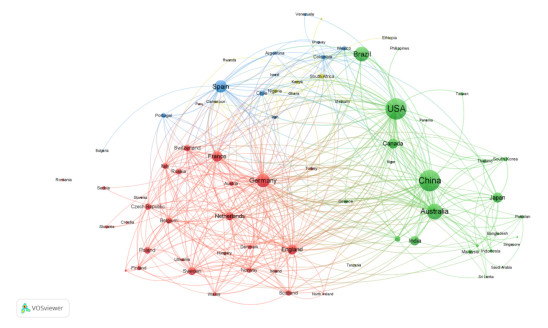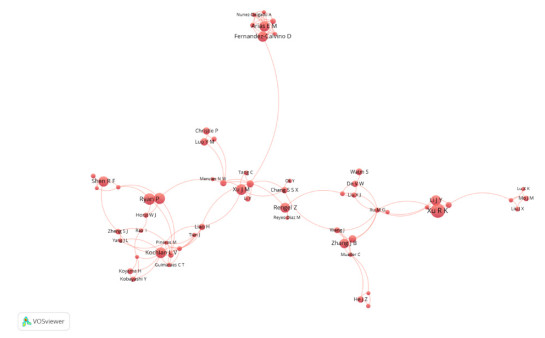我国酸性土壤主要分布于南方和东北部分地区[1],其中南方地区以第四纪红土、红砂岩红壤和板页岩红壤酸化较为严重[2]。土壤酸化本身是一个缓慢的自然过程,但人为活动大大加剧了土壤酸化程度,从而对酸性土壤的可持续利用造成巨大威胁。Guo等[3]通过大数据分析发现,1980—2000年间我国农田土壤出现显著酸化,土壤pH平均下降了0.13 ~ 0.80个单位。此外,森林土壤和茶园土壤也出现了明显的酸化趋势[4-6]。许多区域也报道了土壤酸化,例如南方江西余江县和鄱阳湖等地红壤pH大幅下降[7-8],山东省也呈现严重的土壤酸化趋势[9]。酸化会带来一系列负面影响,如养分有效性下降(作物养分吸收降低)[10]、增加土壤铝毒和锰毒[11],土壤微生物多样性和活性受到抑制[12-13]、土壤重金属生物有效性增加等[14],从而严重威胁粮食安全和农田可持续发展[15-16]。有学者预测,按照目前农业集约化模式发展,未来30a非石灰性土壤pH和盐基饱和度将大幅度下降,大约13% 的农田将遭受铝毒的影响[17]。综上所述,我国土壤酸化形势严峻,不容忽视,采取科学有效的方法来减缓土壤酸化刻不容缓。
近年来,我国土壤酸化问题已经成为环境和土壤领域共同关注的热点之一,相关的科研文献也逐年增多。为了全面了解土壤酸化和改良领域的发展趋势,本研究采用文献计量的研究方法,运用VOSviewer和CiteSpace等文献计量可视化软件,探索土壤酸化和改良的研究热点,以期为我国酸性土壤可持续发展提供重要理论依据。
1 文献来源与统计方法 1.1 文献来源利用美国汤森路透公司的Web of Science的核心合集数据库,检索时间段为1990年1月1日至2019年12月31日,检索时间2020年5月31日,以主题词Topic=“acid* soil*” or “soil acidi*”作为检索式,检索出结果后,选定文献类型Article和Review进行精炼,最终检索出的文献数量为10 193篇。专利检索以万方专利数据库为文献来源,检索时间段选在近10年(2010—2019年),以酸化、酸性土壤改良剂、调理剂为主题词,经过筛选和剔除,共检索到专利文献297篇。
1.2 统计方法利用CiteSpace软件、VOSviewer软件、HistCite软件、Office Excel 2016软件,对1990—2019年的期刊文献分别从发文量,学科分布,国家、机构、作者之间的合作关系,期刊引用,关键词共现和发展趋势进行文献计量分析。CiteSpace分析的节点类型(Node Types)选择学科领域(Category)分析学科分布,通过VOSviewer科研合作网格来分析主要的发文国家、机构和作者之间的合作关系,并分析节点间的连接总强度。基于VOSviewer的共现分析(Co-occurrence),选定所有关键词(All keywords)这一选项,并设置阈值(25)统计出现频次较多的关键词,并合并同义词(例如单复数差异,英美拼写差异等),反映该领域的研究热点。此外,利用HistCite中本地总引用次数(TLCS)与总引用次数(TGCS)两个重要参数来确定土壤酸化领域的主要学术期刊。利用Excel软件来统计发明专利文献中酸化土壤改良材料的应用趋势。
2 结果与分析 2.1 1990—2019年间的发文量和学科分布检索结果表明,土壤酸化和酸性土壤的相关研究论文有逐年上升的趋势,而且年度发表文章数量和累积数量均呈现二次函数的增长趋势(图 1),表明论文增长速率逐年加快。因此,关于土壤酸化和酸性土壤的相关研究得到越来越多的重视。

|
图 1 1990—2019年期刊论文年发文量和累计发文量变化趋势 Fig. 1 Trend of annual and cumulative publication numbers of journal articles from 1990 to 2019 |
利用CiteSpace进行领域的共现分析表明,土壤酸化及其改良材料的相关研究涉及多个研究领域,同时引起多个学科的关注。发文数量排在前3的领域有农学、土壤科学和环境科学与生态学,但中介中心性较高的领域有化学、农学和环境科学与生态学(表 1)。值得注意的是,土壤科学领域中介中心性较低,表明土壤科学在土壤酸化研究领域与其他学科交叉有限,然而土壤科学在土壤酸化防止及其机理研究具有优势,所以应当加强土壤学工作者在土壤酸化防治领域和其他学科的共同发展。
|
|
表 1 发文数量与中介中心性排名前十的学科 Table 1 Top 10 disciplines in terms of paper numbers and intermediary centrality |
关键词简要表达全文主旨,代表文章主要研究内容,一个关键词出现频率越大,表示相关主题受关注程度就越高。土壤酸化和酸性土壤研究领域大致可以概括为四大类,一是土壤酸化成因及其生物化学过程领域;二是土壤酸化中铝毒对植物生长胁迫的生理机制领域;三是土壤酸化引起重金属活化及其钝化领域;四是土壤酸化改良材料领域(图 2)。我国学者对土壤酸化的领域近年来偏重于分析土壤微生物化学过程,酸化土壤改良材料偏向于生物质炭等新型改良剂的研究(图 3)。

|
图 2 关键词共现网络 Fig. 2 Co-occurrence network of keywords |

|
图 3 关键词时区分析 Fig. 3 Time-zone analysis of keywords |
森林土壤(forest soil)、农田土壤(agricultural soil)和草原土壤(grassland soil)等自然和人工生态系统均出现了土壤酸化现象,而氮肥(nitrogen、nitrate)、酸沉降(acidic deposition、precipitation)这些关键词代表土壤酸化成因及其生物化学过程(图 2)。这与许多研究一致,化学氮肥的过量施用(氮循环)、阳离子吸收淋洗和酸沉降是土壤酸化的重要因素[18-28],其中氮肥大量施用及其利用率低是土壤加速酸化的直接驱动因素[29-30]。大气氮/酸沉降是森林土壤酸化的主要原因[31],对土壤酸化的贡献率达到84%[32]。但在农田等人工生态系统中,氮循环过程(铵态氮的输入、硝化和硝酸盐的淋失)是H+产生的主要来源,是土壤酸化的主要驱动因素[33],另外作物对盐基离子吸收是次要因素[34]。土壤酸化的生物化学过程也是学者关注热点,铵态氮肥施加到土壤后,铵态氮的硝化作用产生H+,而硝化细菌和古菌是其中的主要驱动者[35],此外,酶活性(enzyme activity,2010年)、微生物群落结构(microbial community,2013年)、细菌(bacteria,2013年)、丰度(abundance,2016年)对土壤酸化的响应均是近几年的研究热点。稻田土壤pH是细菌群落和丰富度的主要因素[36]。另外,有研究表明长期施肥后旱地红壤细菌群落主要受土壤pH的影响[13]。
2.2.2 土壤酸化和重金属活化的关系该聚类中重金属(heavy metal)、镉(cadmium)、铜(copper)、锌(zinc)、形态(speciation)、生物有效性(availability)、吸附(adsorption)和钝化(immobilization)成为高频共现关键词(图 2)。原因在于土壤pH是土壤生物有效性和形态的主要影响因素,与后者生物有效性呈负相关,即酸性条件下生物有效性更高[37-42]。因此,许多研究采用碱性材料通过改良土壤酸度来钝化土壤重金属,从而降低重金属的作物吸收和人体摄入的风险。有研究指出,相比其他材料,碱性材料(如石灰石和钙镁磷肥)对土壤镉钝化的效果更为显著[43],对土壤微生物群落结构改善的效果更明显[44]。例如许多研究利用石灰、钙镁磷肥和生物质炭等碱性材料来钝化土壤重金属[45-50],同时缓解了土壤酸化问题。
2.2.3 土壤酸化引起的土壤铝毒及其植物耐性的关系该聚类中铝(aluminum)、铝毒(aluminum toxicity)、基因(gene)、耐性(tolerance)、根部(root)、根际(rhizosphere)和根系生长(root growth)等成为高频共现关键词(图 2)。该类研究主要围绕铝的化学形态、作物在酸性土壤胁迫下铝毒对作物生长发育抑制和耐受机理[51-52]。有研究报道,我国南方红壤的酸化程度和铝毒日益加重,从而降低了耕地的质量和生产力[53]。土壤酸化导致活性铝的释放[54],使土壤溶液中交换性铝和CaCl2提取铝含量增加[55],从而可能对敏感植物产生毒害作用。因此,许多学者采用石灰等碱性物质和有机物料降低土壤活性铝含量,从而缓解对作物的铝毒害[56-58]。
2.2.4 酸性土壤改良材料及其研究进展该聚类以土壤改良(soil amendment)、石灰(lime)、粪肥(manure)、秸秆(residues)、生物质炭(biochar)、磷肥(phosphorus)、钾肥(potassium)和钙肥(calcium)为高频共现关键词(图 2)。这些材料不仅能改良酸性土壤,还能钝化重金属,同时提高土壤钙磷钾等养分含量和有效性。由时空图和专利文献土壤酸化改良材料可见,近10 a来,畜禽粪便(manure,2014年)、作物秸秆(residue,2014年)和生物质炭(biochar,2015年)逐渐成为热门的酸化土壤改良材料(图 3和表 2)。专利文献中改良材料可以看出,石灰类、草木灰、农业和工业废弃物/副产品以及天然矿物类等是应用较多的材料(表 2)。此外,生物质炭、天然高分子、腐植酸盐类和钙镁磷肥等新型改良材料在近年来应用也越来越多。天然高分子材料包括纤维素、木质素、壳聚糖、糠醛和海藻酸盐等得到学者越来越多的青睐。
|
|
表 2 专利文献位列前十的酸性土壤改良材料应用频次和频率 Table 2 Usage frequencies and rates of top 10 amendments for acid soil based on patents |
传统酸性改良剂多采用生石灰、熟石灰和石灰石等碱性材料,效果虽然迅速且明显[59],并且有效提高了酸性土壤作物对养分的吸收[60-61],但长期大量施用容易导致土壤板结、钙镁钾锌等养分失调、复酸化等不良现象[62-63],还有研究指出施用石灰不能恢复长期施肥改变的土壤微生物功能[64]。近年来多用白云石、钾长石等矿物类改良剂,能同时补充钙、镁和钾等矿物质[65-66],但缺乏有机质的补充,而且开采成本较高。许多研究也采用碱渣、钢渣、镁渣、赤泥、粉煤灰等工业废弃物作为酸性土壤改良剂[67-69],它们本身具备较高的碱度,同时也能补充磷、钙、镁等营养元素,但由于本身常常含有重金属等污染物质,所以有二次污染的风险,应当谨慎使用[70-1]。近年来许多研究采用钙镁磷肥或者硅钙钾镁肥等新型碱性矿质肥料来改良酸性土壤,它们不仅能降低土壤酸度,还能补充交换性盐基离子和有效磷、硅等营养元素[72-75],效果持久,是值得推广应用的酸性改良剂。
有机肥(作物秸秆和粪肥等)本身具有碱度,能弥补土壤盐基不足,从而减缓土壤酸化[76]。作物秸秆富含有机弱酸盐(例如草酸盐)和盐基离子[77],通过脱羧反应减缓土壤酸化[78]。但是作物秸秆也可能会加剧土壤酸化,这取决于秸秆本身的碱度、C/N和土壤初始pH[79]。施用粪肥(鸡粪、猪粪和牛粪等)可提高土壤pH、酸碱缓冲容量和养分等[10, 80-84],从而减缓土壤酸化和提高土壤肥力以及作物产量[85-87],其作用机制在于弱酸性官能团解离引起的有机阴离子质子化形成中性分子,同时释放盐基阳离子进入土壤溶液,从而提高土壤pH和土壤酸碱缓冲容量[88]。但粪肥本身可能存在重金属超标,容易造成土壤和作物重金属超标等二次污染问题[89]。
生物质炭(biochar)本身呈碱性,含碳量高,是近年来受关注的新型酸性土壤改良剂[90-91],可以提高酸性土壤pH和土壤养分的有效性[92-95],而且能缓解铝毒对作物生长的抑制作用[96-99]。原因在于生物质炭自身含有碳酸盐、含氧官能团和硅酸盐是改良有效成分[100],其作用机理是通过羧基的质子化和碳酸盐的溶解来释放盐基阳离子[101],或通过抑制硝化作用来减缓土壤酸化[102-103]。例如玉米秸秆炭[104]、小麦秸秆炭[105]、花生秸秆炭[106]、菌糠生物炭[107]等可显著提高土壤pH和降低交换性Al3+含量,从而减缓土壤酸化。郭春雷等[108]、杨彩迪和卢升高[109]分别在棕壤和红壤进行土壤酸化改良试验,秸秆炭化还田对阻控土壤酸化、提高阳离子交换量和有机质的效果优于秸秆直接还田[110]。
2.3 发文的国家/机构/作者合作关系利用VOSviewer可视化软件对世界各国在土壤酸化领域发文数量及其各国间的合作关系进行分析(图 4)。图中圈的大小反映了国家/地区的发文数量,连线则表示国家间合作的紧密程度。发文数量统计结果显示美国最多(发文1 605篇),其次为中国(发文1 572篇),德国、澳大利亚、英国、法国、西班牙、荷兰、巴西和瑞士等国家均在土壤酸化和酸性土壤相关领域发表了许多优秀论文。从图中可以看出,美国、加拿大、中国、澳大利亚、新西兰、英国、德国、法国、西班牙和巴西等国家之间在土壤酸化研究领域的合作关系密切。

|
图 4 论文产出国之间的合作 Fig. 4 Cooperation between paper contributors' countries |
由机构合作网络(图 5)可见,中国科学院(Chinese Acad Sci)与其他主要论文产出机构的合作关系最为密切,它与中国科学院大学(Univ Chinese Acad Sci)、中国农业大学(China Agr Univ)、、浙江大学(Zhejiang Univ)和南京农业大学(Nanjing Agr Univ)有密切合作关系,同时与国外的康奈尔大学(Cornell Univ)、佛罗里达大学(Univ Florida)、西澳大学(Univ Western Australia)、瑞典农业科学大学(Swedish Univ Agr Sci)以及法国农业科学研究院(Inra)有良好的国际合作关系。此外,美国农业部农业研究组织(Usda Ars)和西班牙高等科学研究理事会(Csic)在国际间均有密切合作关系。

|
图 5 论文产出主要机构之间的合作 Fig. 5 Cooperation between main paper contributors' institutions |
图 6为合作关系较为密切的作者之间的联系,圆圈大小表示作者发文数量的多少。从发文数量上看,Baligar V C(发文60篇),Xu R K(徐仁扣,发文60篇),Fageria N K(发文50)、Rengel Z(发文46篇)和Kochian L V(发文44篇)等是高产作者,其中学者Kochian L V的被引用次数最高,表明其影响力最大。另外根据作者合作关系图可以看出,国内知名学者徐仁扣(Xu R K)、李九玉(Li J Y)、沈仁芳(Shen R F)、徐明岗(Xu M G)、刘菊秀(Liu J X)、贺纪正(He J Z)之间有密切合作关系,同时与国外学者Baligar V C、Fageria N K、Rengel Z和Kochian L V也有较为密切的合作关系。

|
图 6 重要作者之间的合作关系 Fig. 6 Cooperation between important authors |
由HistCite软件分析结果可见,发文数量前3的期刊是Plant and Soil (发文440篇),Communications in Soil Science and Plant Analysis (发文433篇)和Soil Biology & Biochemistry(发文255篇)。本地引用次数和总引用次数较高的期刊有Plant and Soil、Soil Biology & Biochemistry、Forest Ecology and Management、Geoderma、Science of the Total Environment等,说明这些期刊具有较高的被引率和影响力。高被引期刊主要关注环境、土壤和植物营养科学这3个方面,表明当前研究方向主要是以上3个领域。
|
|
表 3 1990—2019年土壤酸化领域研究发文量排名TOP10期刊 Table 3 Top 10 journals in terms of paper numbers published on soil acidification during 1990—2019 |
1) 关于土壤酸化及其改良的文章呈现逐年上升趋势,并且年发文量和累积量呈现二次型增长的模式。
2) 研究领域主要有土壤酸化成因及其生物化学过程、由酸化引起的重金属活化和钝化、土壤铝毒及其缓解、酸化改良材料等4大方面。
3) 酸化土壤改良方向集中于生物质炭、工业废弃物/副产品、农业废弃物/副产品和矿物类等材料。天然高分子材料、钙镁磷肥、微生物菌剂和腐植酸盐等成为新兴酸化土壤改良材料的方向和未来研究热点。
4) 文章高产国家主要集中在中国、美国和澳大利亚等农业大国;高产机构主要集中在高校和研究所,中国科学院、中国科学院大学和西澳大学等机构有密切合作关系;高产作者Baligar V C,Xu R K(徐仁扣),Fageria N K等有密切合作关系。
| [1] |
Chen S C, Liang Z Z, Webster R, et al. A high-resolution map of soil pH in China made by hybrid modelling of sparse soil data and environmental covariates and its implications for pollution[J]. Science of the Total Environment, 2019, 655: 273-283 DOI:10.1016/j.scitotenv.2018.11.230 (  0) 0) |
| [2] |
赵凯丽, 蔡泽江, 王伯仁, 等. 不同母质和植被类型下红壤pH和交换性酸的剖面特征[J]. 中国农业科学, 2015, 48(23): 4818-4826 DOI:10.3864/j.issn.0578-1752.2015.23.023 (  0) 0) |
| [3] |
Guo J H, Liu X J, Zhang Y, et al. Significant acidification in major Chinese croplands[J]. Science, 2010, 327(5968): 1008-1010 DOI:10.1126/science.1182570 (  0) 0) |
| [4] |
颜鹏, 韩文炎, 李鑫, 等. 中国茶园土壤酸化现状与分析[J]. 中国农业科学, 2020, 53(4): 795-813 (  0) 0) |
| [5] |
Yan P, Wu L Q, Wang D H, et al. Soil acidification in Chinese tea plantations[J]. Science of the Total Environment, 2020, 715: 136963 DOI:10.1016/j.scitotenv.2020.136963 (  0) 0) |
| [6] |
Šantrůčková H, Cienciala E, Kaňa J, et al. The chemical composition of forest soils and their degree of acidity in Central Europe[J]. Science of the Total Environment, 2019, 687: 96-103 DOI:10.1016/j.scitotenv.2019.06.078 (  0) 0) |
| [7] |
张忠启, 茆彭, 于东升, 等. 近25年来典型红壤区土壤pH变化特征——以江西省余江县为例[J]. 土壤学报, 2018, 55(6): 1545-1553 (  0) 0) |
| [8] |
Guo X, Li H Y, Yu H M, et al. Drivers of spatio-temporal changes in paddy soil pH in Jiangxi Province, China from 1980 to 2010[J]. Scientific Reports, 2018, 8: 2702 DOI:10.1038/s41598-018-20873-5 (  0) 0) |
| [9] |
杨歆歆, 赵庚星, 李涛, 等. 山东省土壤酸化特征及其影响因素分析[J]. 农业工程学报, 2016, 32(S2): 155-160 (  0) 0) |
| [10] |
蔡泽江, 孙楠, 王伯仁, 等. 长期施肥对红壤pH、作物产量及氮、磷、钾养分吸收的影响[J]. 植物营养与肥料学报, 2011, 17(1): 71-78 (  0) 0) |
| [11] |
Zhao X Q, Shen R F. Aluminum-nitrogen interactions in the soil-plant system[J]. Frontiers in Plant Science, 2018, 9: 807 DOI:10.3389/fpls.2018.00807 (  0) 0) |
| [12] |
Wan W J, Tan J D, Wang Y, et al. Responses of the rhizosphere bacterial community in acidic crop soil to pH: Changes in diversity, composition, interaction, and function[J]. Science of the Total Environment, 2020, 700: 134418 DOI:10.1016/j.scitotenv.2019.134418 (  0) 0) |
| [13] |
刘佳, 陈晓芬, 刘明, 等. 长期施肥对旱地红壤细菌群落的影响[J]. 土壤学报, 2020, 57(2): 468-478 (  0) 0) |
| [14] |
杨秀敏, 任广萌, 李立新, 等. 土壤pH值对重金属形态的影响及其相关性研究[J]. 中国矿业, 2017, 26(6): 79-83 DOI:10.3969/j.issn.1004-4051.2017.06.015 (  0) 0) |
| [15] |
张玲玉, 赵学强, 沈仁芳. 土壤酸化及其生态效应[J]. 生态学杂志, 2019, 38(6): 1900-1908 (  0) 0) |
| [16] |
Zhu Q C, Liu X J, Hao T X, et al. Cropland acidification increases risk of yield losses and food insecurity in China[J]. Environmental Pollution, 2020, 256: 113145 DOI:10.1016/j.envpol.2019.113145 (  0) 0) |
| [17] |
Zhu Q C, Liu X J, Hao T X, et al. Modeling soil acidification in typical Chinese cropping systems[J]. Science of the Total Environment, 2018, 613/614: 1339-1348 DOI:10.1016/j.scitotenv.2017.06.257 (  0) 0) |
| [18] |
周晓阳, 徐明岗, 周世伟, 等. 长期施肥下我国南方典型农田土壤的酸化特征[J]. 植物营养与肥料学报, 2015, 21(6): 1615-1621 (  0) 0) |
| [19] |
孟红旗, 刘景, 徐明岗, 等. 长期施肥下我国典型农田耕层土壤的pH演变[J]. 土壤学报, 2013, 50(6): 1109-1116 (  0) 0) |
| [20] |
周碧青, 邱龙霞, 张黎明, 等. 基于灰色关联-结构方程模型的土壤酸化驱动因子研究[J]. 土壤学报, 2018, 55(5): 1233-1242 (  0) 0) |
| [21] |
李艾芬, 麻万诸, 章明奎. 水稻土的酸化特征及其起因[J]. 江西农业学报, 2014, 26(1): 72-76 DOI:10.3969/j.issn.1001-8581.2014.01.020 (  0) 0) |
| [22] |
沈仁芳, 赵学强. 酸性土壤可持续利用[J]. 农学学报, 2019, 9(3): 16-20 (  0) 0) |
| [23] |
毛伟, 李文西, 高晖, 等. 扬州市耕地土壤pH值30年演变及其驱动因子[J]. 植物营养与肥料学报, 2017, 23(4): 883-893 (  0) 0) |
| [24] |
张秀, 张黎明, 龙军, 等. 亚热带耕地土壤酸化程度差异及影响因素[J]. 中国生态农业学报, 2017, 25(3): 441-450 (  0) 0) |
| [25] |
Schroder J L, Zhang H L, Girma K, et al. Soil acidification from long-term use of nitrogen fertilizers on winter wheat[J]. Soil Science Society of America Journal, 2011, 75(3): 957-964 DOI:10.2136/sssaj2010.0187 (  0) 0) |
| [26] |
Li Q Q, Li S, Xiao Y, et al. Soil acidification and its influencing factors in the purple hilly area of southwest China from 1981 to 2012[J]. CATENA, 2019, 175: 278-285 DOI:10.1016/j.catena.2018.12.025 (  0) 0) |
| [27] |
Zhou J, Xia F, Liu X M, et al. Effects of nitrogen fertilizer on the acidification of two typical acid soils in South China[J]. Journal of Soils and Sediments, 2014, 14(2): 415-422 DOI:10.1007/s11368-013-0695-1 (  0) 0) |
| [28] |
杨昂, 孙波, 赵其国. 中国酸雨的分布、成因及其对土壤环境的影响[J]. 土壤, 1999, 31(1): 3-5 DOI:10.3969/j.issn.1673-6257.1999.01.001 (  0) 0) |
| [29] |
Zhu Q C, de Vries W, Liu X J, et al. Enhanced acidification in Chinese croplands as derived from element budgets in the period 1980-2010[J]. Science of the Total Environment, 2018, 618: 1497-1505 DOI:10.1016/j.scitotenv.2017.09.289 (  0) 0) |
| [30] |
Xiang D Y, Ni K, Shi Y Z, et al. Effects of long-term nitrogen application on soil acidification and solution chemistry of a tea plantation in China[J]. Agriculture, Ecosystems & Environment, 2018, 252: 74-82 (  0) 0) |
| [31] |
肖辉林. 大气氮沉降对森林土壤酸化的影响[J]. 林业科学, 2001, 37(4): 111-116 DOI:10.3321/j.issn:1001-7488.2001.04.018 (  0) 0) |
| [32] |
Zhu Q C, De Vries W, Liu X J, et al. The contribution of atmospheric deposition and forest harvesting to forest soil acidification in China since 1980[J]. Atmospheric Environment, 2016, 146: 215-222 DOI:10.1016/j.atmosenv.2016.04.023 (  0) 0) |
| [33] |
周海燕, 徐明岗, 蔡泽江, 等. 湖南祁阳县土壤酸化主要驱动因素贡献解析[J]. 中国农业科学, 2019, 52(8): 1400-1412 (  0) 0) |
| [34] |
Zeng M F, de Vries W, Bonten L T C, et al. Model-based analysis of the long-term effects of fertilization management on cropland soil acidification[J]. Environmental Science & Technology, 2017, 51(7): 3843-3851 (  0) 0) |
| [35] |
佟德利, 徐仁扣. 三种氮肥对红壤硝化作用及酸化过程影响的研究[J]. 植物营养与肥料学报, 2012, 18(4): 853-859 (  0) 0) |
| [36] |
Hou J Y, Wu L H, Liu W X, et al. Biogeography and diversity patterns of abundant and rare bacterial communities in rice paddy soils across China[J]. Science of the Total Environment, 2020, 730: 139116 DOI:10.1016/j.scitotenv.2020.139116 (  0) 0) |
| [37] |
王锐, 胡小兰, 张永文, 等. 重庆市主要农耕区土壤Cd生物有效性及影响因素[J]. 环境科学, 2020, 41(4): 1864-1870 (  0) 0) |
| [38] |
Ning Y Z, Zhang X M, Li B Z, et al. Distribution of Cd and Cu fractions in Chinese soils and their relationships with soil pH: A meta-analysis[J]. Sustainability, 2019, 11(2): 337 DOI:10.3390/su11020337 (  0) 0) |
| [39] |
Tian H Q, Wang Y Z, Xie J F, et al. Effects of soil properties and land use types on the bioaccessibility of Cd, Pb, Cr, and Cu in Dongguan city, China[J]. Bulletin of Environmental Contamination and Toxicology, 2020, 104(1): 64-70 DOI:10.1007/s00128-019-02740-9 (  0) 0) |
| [40] |
Zheng S N, Wang Q, Yu H Y, et al. Interactive effects of multiple heavy metal(loid)s on their bioavailability in cocontaminated paddy soils in a large region[J]. Science of the Total Environment, 2020, 708: 135126 DOI:10.1016/j.scitotenv.2019.135126 (  0) 0) |
| [41] |
窦韦强, 安毅, 秦莉, 等. 土壤pH对镉形态影响的研究进展[J]. 土壤, 2020, 52(3): 439-444 (  0) 0) |
| [42] |
王一志, 曹雪莹, 谭长银, 等. 不同土壤pH对红壤稻田镉形态及水稻镉积累的影响[J]. 湖南师范大学自然科学学报, 2017, 40(1): 10-16 (  0) 0) |
| [43] |
Palansooriya K N, Shaheen S M, Chen S S, et al. Soil amendments for immobilization of potentially toxic elements in contaminated soils: A critical review[J]. Environment International, 2020, 134: 105046 DOI:10.1016/j.envint.2019.105046 (  0) 0) |
| [44] |
Lu H L, Wu Y X, Liang P X, et al. Alkaline amendments improve the health of soils degraded by metal contamination and acidification: Crop performance and soil bacterial community responses[J]. Chemosphere, 2020, 257: 127309 DOI:10.1016/j.chemosphere.2020.127309 (  0) 0) |
| [45] |
Du Y Y, Wang X, Ji X H, et al. Effectiveness and potential risk of CaO application in Cd-contaminated paddy soil[J]. Chemosphere, 2018, 204: 130-139 DOI:10.1016/j.chemosphere.2018.04.005 (  0) 0) |
| [46] |
Wang Y F, Ying Y Q, Lu S G. Si-Ca-K-Mg amendment reduces the phytoavailability and transfer of Cd from acidic soil to rice grain[J]. Environmental Science and Pollution Research International, 2020, 27(26): 33248-33258 DOI:10.1007/s11356-020-09444-2 (  0) 0) |
| [47] |
Zhang X K, Wang H L, He L Z, et al. Using biochar for remediation of soils contaminated with heavy metals and organic pollutants[J]. Environmental Science and Pollution Research, 2013, 20(12): 8472-8483 DOI:10.1007/s11356-013-1659-0 (  0) 0) |
| [48] |
曹胜, 欧阳梦云, 周卫军, 等. 石灰对土壤重金属污染修复的研究进展[J]. 中国农学通报, 2018, 34(26): 109-112 (  0) 0) |
| [49] |
李江遐, 关强, 黄伏森, 等. 不同改良剂对矿区土壤重金属有效性及土壤酶活性的影响[J]. 水土保持学报, 2014, 28(6): 211-215 (  0) 0) |
| [50] |
张莹, 吴萍, 孙庆业, 等. 长期施用生物炭对土壤中Cd吸附及生物有效性的影响[J]. 农业环境科学学报, 2020, 39(5): 1019-1025 (  0) 0) |
| [51] |
张冉, 韩博, 任健, 等. 铝对植物毒害及草本植物耐铝毒机制研究进展[J]. 云南农业大学学报(自然科学), 2020, 35(2): 353-360 (  0) 0) |
| [52] |
许小丽, 张金彪. 森林土壤-植物系统铝毒害及防治研究进展[J]. 生态学杂志, 2017, 36(4): 1106-1116 (  0) 0) |
| [53] |
吴道铭, 傅友强, 于智卫, 等. 我国南方红壤酸化和铝毒现状及防治[J]. 土壤, 2013, 45(4): 577-584 (  0) 0) |
| [54] |
Sukitprapanon T, Suddhiprakarn A, Kheoruenromne I, et al. Partitioning and potential mobilization of aluminum, arsenic, iron, and heavy metals in tropical active and post-active acid sulfate soils: Influence of long-term paddy rice cultivation[J]. Chemosphere, 2018, 197: 691-702 DOI:10.1016/j.chemosphere.2018.01.099 (  0) 0) |
| [55] |
徐仁扣, D.R.Coventry. 某些农业措施对土壤酸化的影响[J]. 农业环境保护, 2002, 21(5): 385-388 (  0) 0) |
| [56] |
Zhao W R, Li J Y, Jiang J, et al. The mechanisms underlying the reduction in aluminum toxicity and improvements in the yield of sweet potato (Ipomoea batatas L.) After organic and inorganic amendment of an acidic ultisol[J]. Agriculture, Ecosystems & Environment, 2020, 288: 106716 (  0) 0) |
| [57] |
Kryzevicius Z, Karcauskiene D, Álvarez-Rodríguez E, et al. The effect of over 50 years of liming on soil aluminium forms in a Retisol[J]. The Journal of Agricultural Science, 2019, 157(1): 12-19 DOI:10.1017/S0021859619000194 (  0) 0) |
| [58] |
Zhao W R, Li J Y, Deng K Y, et al. Effects of crop straw biochars on aluminum species in soil solution as related with the growth and yield of canola (Brassica napus L.) in an acidic Ultisol under field condition[J]. Environmental Science and Pollution Research, 2020, 27(24): 30178-30189 DOI:10.1007/s11356-020-09330-x (  0) 0) |
| [59] |
鲁艳红, 廖育林, 聂军, 等. 长期施用氮磷钾肥和石灰对红壤性水稻土酸性特征的影响[J]. 土壤学报, 2016, 53(1): 202-212 (  0) 0) |
| [60] |
曾廷廷, 蔡泽江, 王小利, 等. 酸性土壤施用石灰提高作物产量的整合分析[J]. 中国农业科学, 2017, 50(13): 2519-2527 DOI:10.3864/j.issn.0578-1752.2017.13.011 (  0) 0) |
| [61] |
闫志浩, 胡志华, 王士超, 等. 石灰用量对水稻油菜轮作区土壤酸度、土壤养分及作物生长的影响[J]. 中国农业科学, 2019, 52(23): 4285-4295 DOI:10.3864/j.issn.0578-1752.2019.23.009 (  0) 0) |
| [62] |
孟赐福, 傅庆林, 水建国, 等. 浙江中部红壤施用石灰对土壤交换性钙、镁及土壤酸度的影响[J]. 植物营养与肥料学报, 1999, 5(2): 3-5 (  0) 0) |
| [63] |
胡敏, 向永生, 鲁剑巍. 石灰用量对酸性土壤pH值及有效养分含量的影响[J]. 中国土壤与肥料, 2017(4): 72-77 (  0) 0) |
| [64] |
Ma B, Lv X, Cai Y J, et al. Liming does not counteract the influence of long-term fertilization on soil bacterial community structure and its co-occurrence pattern[J]. Soil Biology and Biochemistry, 2018, 123: 45-53 DOI:10.1016/j.soilbio.2018.05.003 (  0) 0) |
| [65] |
文星, 李明德, 吴海勇, 等. 土壤改良剂对酸性水稻土pH值、交换性钙镁及有效磷的影响[J]. 农业现代化研究, 2014, 35(5): 618-623 (  0) 0) |
| [66] |
张国, 朱启法, 郭熙盛, 等. 皖南烟区白云石粉对酸性植烟土壤的改良研究[J]. 土壤, 2014, 46(3): 534-538 (  0) 0) |
| [67] |
李九玉, 王宁, 徐仁扣. 工业副产品对红壤酸度改良的研究[J]. 土壤, 2009, 41(6): 932-939 DOI:10.3321/j.issn:0253-9829.2009.06.015 (  0) 0) |
| [68] |
刘鸣达, 张玉龙, 王耀晶, 等. 施用钢渣对水稻土pH、水溶态硅动态及水稻产量的影响[J]. 土壤通报, 2002, 33(1): 47-50 DOI:10.3321/j.issn:0564-3945.2002.01.013 (  0) 0) |
| [69] |
Shi R Y, Li J Y, Xu R K, et al. Ameliorating effects of individual and combined application of biomass ash, bone meal and alkaline slag on acid soils[J]. Soil and Tillage Research, 2016, 162: 41-45 DOI:10.1016/j.still.2016.04.017 (  0) 0) |
| [70] |
Egerić M, Smičiklas I, Dojčinović B, et al. Interactions of acidic soil near copper mining and smelting complex and waste-derived alkaline additives[J]. Geoderma, 2019, 352: 241-250 DOI:10.1016/j.geoderma.2019.06.015 (  0) 0) |
| [71] |
Wang X B, Yan X, Li X Y. Environmental risks for application of magnesium slag to soils in China[J]. Journal of Integrative Agriculture, 2020, 19(7): 1671-1679 DOI:10.1016/S2095-3119(19)62835-2 (  0) 0) |
| [72] |
冀建华, 李絮花, 刘秀梅, 等. 硅钙钾镁肥对南方稻田土壤酸度的改良作用[J]. 土壤学报, 2019, 56(4): 895-906 (  0) 0) |
| [73] |
冀建华, 李絮花, 刘秀梅, 等. 硅钙钾镁肥对南方稻田土壤酸性和盐基离子动态变化的影响[J]. 应用生态学报, 2019, 30(2): 583-592 (  0) 0) |
| [74] |
易琼, 杨少海, 黄巧义, 等. 改良剂对反酸田土壤性质与水稻产量的影响[J]. 土壤学报, 2014, 51(1): 176-183 (  0) 0) |
| [75] |
侯翠红, 苗俊艳, 谷守玉, 等. 以钙镁磷肥产品创新促进产业发展[J]. 植物营养与肥料学报, 2019, 25(12): 2162-2169 DOI:10.11674/zwyf.19172 (  0) 0) |
| [76] |
孟红旗, 吕家珑, 徐明岗, 等. 有机肥的碱度及其减缓土壤酸化的机制[J]. 植物营养与肥料学报, 2012, 18(5): 1153-1160 (  0) 0) |
| [77] |
Butterly C R, Baldock J A, Tang C. The contribution of crop residues to changes in soil pH under field conditions[J]. Plant and Soil, 2013, 366(1/2): 185-198 (  0) 0) |
| [78] |
Cai Z J, Xu M G, Zhang L, et al. Decarboxylation of organic anions to alleviate acidification of red soils from urea application[J]. Journal of Soils and Sediments, 2020, 20(8): 3124-3135 DOI:10.1007/s11368-020-02630-2 (  0) 0) |
| [79] |
王伯仁. 红壤质量演变与培肥技术[Z]. 北京: 中国农业科学技术出版社, 2015.
(  0) 0) |
| [80] |
汪吉东, 张辉, 张永春, 等. 连续施用不同比例鸡粪氮对水稻土有机质积累及土壤酸化的影响[J]. 植物营养与肥料学报, 2014, 20(5): 1178-1185 (  0) 0) |
| [81] |
陕红. 有机物料对土壤酸碱度的影响[J]. 中国农学通报, 2017, 33(32): 70-76 DOI:10.11924/j.issn.1000-6850.casb16100077 (  0) 0) |
| [82] |
Cai Z J, Wang B R, Xu M G, et al. Nitrification and acidification from urea application in red soil (Ferralic Cambisol) after different long-term fertilization treatments[J]. Journal of Soils and Sediments, 2014, 14(9): 1526-1536 DOI:10.1007/s11368-014-0906-4 (  0) 0) |
| [83] |
Ye G P, Lin Y X, Liu D Y, et al. Long-term application of manure over plant residues mitigates acidification, builds soil organic carbon and shifts prokaryotic diversity in acidic Ultisols[J]. Applied Soil Ecology, 2019, 133: 24-33 DOI:10.1016/j.apsoil.2018.09.008 (  0) 0) |
| [84] |
Cai Z J, Wang B R, Xu M G, et al. Intensified soil acidification from chemical N fertilization and prevention by manure in an 18-year field experiment in the red soil of Southern China[J]. Journal of Soils and Sediments, 2015, 15(2): 260-270 DOI:10.1007/s11368-014-0989-y (  0) 0) |
| [85] |
Cai A D, Xu M G, Wang B R, et al. Manure Acts as a better fertilizer for increasing crop yields than synthetic fertilizer does by improving soil fertility[J]. Soil and Tillage Research, 2019, 189: 168-175 DOI:10.1016/j.still.2018.12.022 (  0) 0) |
| [86] |
Du Y D, Cui B J, zhang Q, et al. Effects of manure fertilizer on crop yield and soil properties in China: A meta-analysis[J]. CATENA, 2020, 193: 104617 DOI:10.1016/j.catena.2020.104617 (  0) 0) |
| [87] |
Wang H X, Xu J L, Liu X J, et al. Effects of long-term application of organic fertilizer on improving organic matter content and retarding acidity in red soil from China[J]. Soil and Tillage Research, 2019, 195: 104382 DOI:10.1016/j.still.2019.104382 (  0) 0) |
| [88] |
Shi R Y, Liu Z D, Li Y, et al. Mechanisms for increasing soil resistance to acidification by long-term manure application[J]. Soil and Tillage Research, 2019, 185: 77-84 DOI:10.1016/j.still.2018.09.004 (  0) 0) |
| [89] |
Wang X B, Liu W X, Li Z G, et al. Effects of long-term fertilizer applications on peanut yield and quality and plant and soil heavy metal accumulation[J]. Pedosphere, 2020, 30(4): 555-562 DOI:10.1016/S1002-0160(17)60457-0 (  0) 0) |
| [90] |
张俊叶, 刘晓东, 王林, 等. 生物质炭的土壤效应研究综述[J]. 中国农学通报, 2020, 36(9): 46-50 (  0) 0) |
| [91] |
Dai Z M, Zhang X J, Tang C, et al. Potential role of biochars in decreasing soil acidification -A critical review[J]. Science of the Total Environment, 2017, 581/582: 601-611 DOI:10.1016/j.scitotenv.2016.12.169 (  0) 0) |
| [92] |
赵牧秋, 金凡莉, 孙照炜, 等. 制炭条件对生物炭碱性基团含量及酸性土壤改良效果的影响[J]. 水土保持学报, 2014, 28(4): 299-303, 309 (  0) 0) |
| [93] |
袁帅, 赵立欣, 孟海波, 等. 生物炭主要类型、理化性质及其研究展望[J]. 植物营养与肥料学报, 2016, 22(5): 1402-1417 (  0) 0) |
| [94] |
杨彩迪, 宗玉统, 卢升高. 不同生物炭对酸性农田土壤性质和作物产量的动态影响[J]. 环境科学, 2020, 41(4): 1914-1920 (  0) 0) |
| [95] |
Xu R K, Zhao A Z, Yuan J H, et al. pH buffering capacity of acid soils from tropical and subtropical regions of China as influenced by incorporation of crop straw biochars[J]. Journal of Soils and Sediments, 2012, 12(4): 494-502 DOI:10.1007/s11368-012-0483-3 (  0) 0) |
| [96] |
应介官, 林庆毅, 张梦阳, 等. 生物炭对铝富集酸性土壤的毒性缓解效应及潜在机制[J]. 中国农业科学, 2016, 49(23): 4576-4583 DOI:10.3864/j.issn.0578-1752.2016.23.010 (  0) 0) |
| [97] |
王宇函, 吕波, 张林, 等. 不同土壤改良剂对酸性铝富集红壤毒性缓解效应的差异[J]. 华中农业大学学报, 2019, 38(2): 73-80 (  0) 0) |
| [98] |
Xia H, Riaz M, Zhang M Y, et al. Biochar increases nitrogen use efficiency of maize by relieving aluminum toxicity and improving soil quality in acidic soil[J]. Ecotoxicology and Environmental Safety, 2020, 196: 110531 DOI:10.1016/j.ecoenv.2020.110531 (  0) 0) |
| [99] |
Shi R Y, Ni N, Nkoh J N, et al. Biochar retards Al toxicity to maize (Zea mays L.) during soil acidification: The effects and mechanisms[J]. Science of the Total Environment, 2020, 719: 137448 DOI:10.1016/j.scitotenv.2020.137448 (  0) 0) |
| [100] |
Shi R Y, Li J Y, Ni N, et al. Understanding the biochar's role in ameliorating soil acidity[J]. Journal of Integrative Agriculture, 2019, 18(7): 1508-1517 DOI:10.1016/S2095-3119(18)62148-3 (  0) 0) |
| [101] |
Shi R Y, Hong Z N, Li J Y, et al. Mechanisms for increasing the pH buffering capacity of an acidic ultisol by crop residue-derived biochars[J]. Journal of Agricultural and Food Chemistry, 2017, 65(37): 8111-8119 DOI:10.1021/acs.jafc.7b02266 (  0) 0) |
| [102] |
Shi R Y, Ni N, Nkoh J N, et al. Beneficial dual role of biochars in inhibiting soil acidification resulting from nitrification[J]. Chemosphere, 2019, 234: 43-51 DOI:10.1016/j.chemosphere.2019.06.030 (  0) 0) |
| [103] |
Wang Z Y, Zong H Y, Zheng H, et al. Reduced nitrification and abundance of ammonia-oxidizing bacteria in acidic soil amended with biochar[J]. Chemosphere, 2015, 138: 576-583 DOI:10.1016/j.chemosphere.2015.06.084 (  0) 0) |
| [104] |
袁金华, 徐仁扣, 俄胜哲, 等. 生物质炭中盐基离子存在形态及其与改良酸性土壤的关系[J]. 土壤, 2019, 51(1): 75-82 (  0) 0) |
| [105] |
Yu L, Lu X, He Y, et al. Combined biochar and nitrogen fertilizer reduces soil acidity and promotes nutrient use efficiency by soybean crop[J]. Journal of Soils and Sediments, 2017, 17(3): 599-610 DOI:10.1007/s11368-016-1447-9 (  0) 0) |
| [106] |
Shi R Y, Hong Z N, Li J Y, et al. Peanut straw biochar increases the resistance of two Ultisols derived from different parent materials to acidification: A mechanism study[J]. Journal of Environmental Management, 2018, 210: 171-179 DOI:10.1016/j.jenvman.2018.01.028 (  0) 0) |
| [107] |
Tong D L, Xu R K. Ameliorating effects of fungus chaff and its biochar on soil acidity[J]. Communications in Soil Science and Plant Analysis, 2015, 46(15): 1913-1921 DOI:10.1080/00103624.2015.1068323 (  0) 0) |
| [108] |
郭春雷, 李娜, 彭靖, 等. 秸秆直接还田及炭化还田对土壤酸度和交换性能的影响[J]. 植物营养与肥料学报, 2018, 24(5): 1205-1213 (  0) 0) |
| [109] |
杨彩迪, 卢升高. 秸秆直接还田和炭化还田对红壤酸度、养分和交换性能的动态影响[J]. 环境科学, 2020, 41(9): 4246-4252 (  0) 0) |
| [110] |
Yuan J H, Xu R K, Qian W, et al. Comparison of the ameliorating effects on an acidic ultisol between four crop straws and their biochars[J]. Journal of Soils and Sediments, 2011, 11(5): 741-750 DOI:10.1007/s11368-011-0365-0 (  0) 0) |
 2021, Vol. 53
2021, Vol. 53


